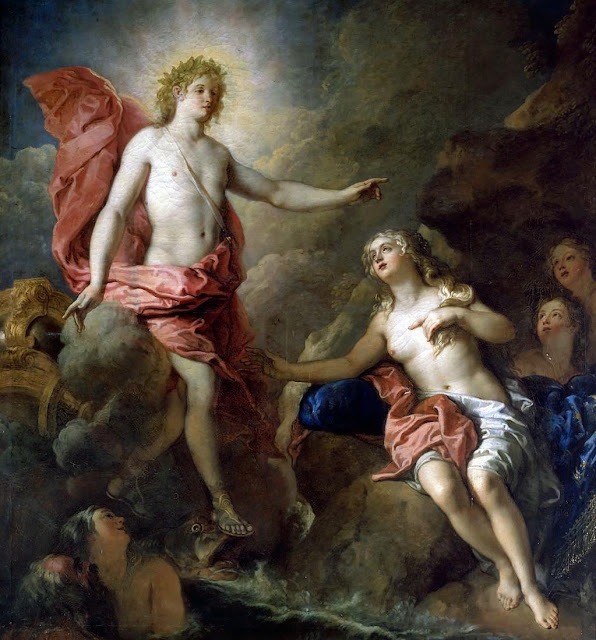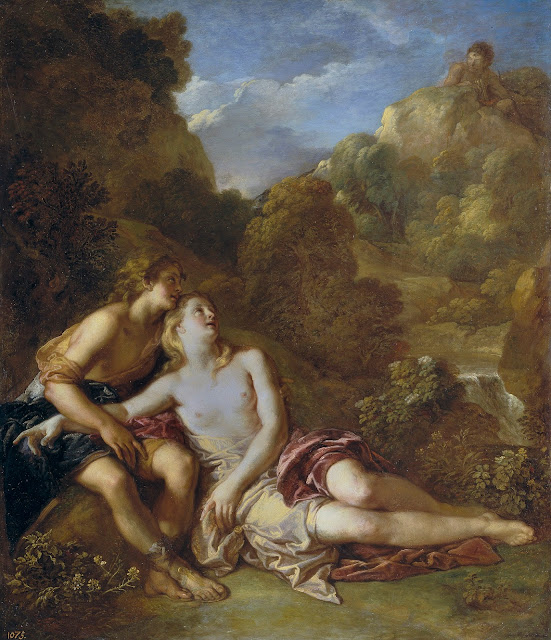 |
| Sébastien Bourdon Baptism of Christ ca. 1650 oil on canvas Metropolitan Museum of Art, New York |
 |
| Nicolas de Largillière Self-portrait as St John the Baptist ca. 1675-78 oil on canvas Musée d'art et d'histoire de Genève |
 |
| Philippe Vignon Portrait of sculptor Philippe de Buyster 1687 oil on canvas Château de Versailles |
 |
| Arnould de Vuez St Zita 1696 oil on canvas Hospice Comtesse, Lille |
"The aspirants generally seem to have borne in mind the main preoccupations of the body – preoccupations that they almost certainly shared – when executing their pictures or statues, whether spontaneously or in an effort to satisfy their judges. They were undoubtedly required to demonstrate a high standard of draftsmanship and to master those rules of the art that could be imparted by teaching, notably anatomy and perspective. But there is near unanimity among the artists who left any kind of statement that a picture could be satisfactorily drawn, well colored, carefully composed – and nevertheless leave the spectator cold. A painting must, they said, make a strong impact on the spectator, either through the beauty of its ideas or the power of its expression – or by whatever else it is that conveys a sense of life: expression, ensemble, grace, truth, enthusiasm, or magic, to adopt some of the terms employed by academicians. By contrast, ideal beauty never served as a criterion by which works could be judged. According to the comte de Caylus, two faculties came into play in the execution of a picture: genius (the fruit of enthusiasm) and taste (which rectified what genius had produced). Genius, he said, could not be acquired; it could only be ignited. By contrast, taste was produced by training and by reflection on the great masters. If we confine ourselves to Caylus's categories, it seems likely that the Académie was content with assessing taste in the works submitted to it but that certain artists strove to execute works reflecting their own genius."
– The Académie Royale de Peinture et de Sculpture: The Birth of the French School, 1648-1793 by Christian Michel, published in France in 2012, translated by Chris Miller and published by Getty Research Institute in 2018
 |
| Charles de La Fosse Sacrifice of Iphigenia 1680 oil on canvas Château de Versailles |
 |
| Charles de La Fosse Apollo and Thetis 1688 oil on canvas Château de Versailles |
 |
| Charles de La Fosse Assumption of the Virgin ca. 1680 oil on canvas Musée des Beaux-Arts de Nancy |
 |
| Charles de La Fosse Acis and Galatea ca. 1699 oil on copper Museo del Prado, Madrid |
 |
| Hyacinthe Rigaud Portrait of Gaspard Rigaud 1691 oil on canvas Musée Hyacinthe Rigaud, Perpignan |
 |
| Hyacinthe Rigaud Portrait of Jean-Baptiste Monginot 1688 oil on canvas private collection |
 |
| Hyacinthe Rigaud Portrait of Pierre-Frédéric Léonard, King's Printer, his wife Marie-Anne des Essarts, and their daughter 1692 oil on canvas Musée du Louvre |
 |
| Hyacinthe Rigaud Portrait of Maximilian Oldrich Kounic 1698 oil on canvas Slavkov Castle, Czech Republic |
 |
| Hyacinthe Rigaud Christ Expiring 1696 oil on canvas Musée Hyacinthe Rigaud, Perpignan |
 |
| Hyacinthe Rigaud Portrait of Pierre-Vincent Bertin 1685 oil on canvas private collection |